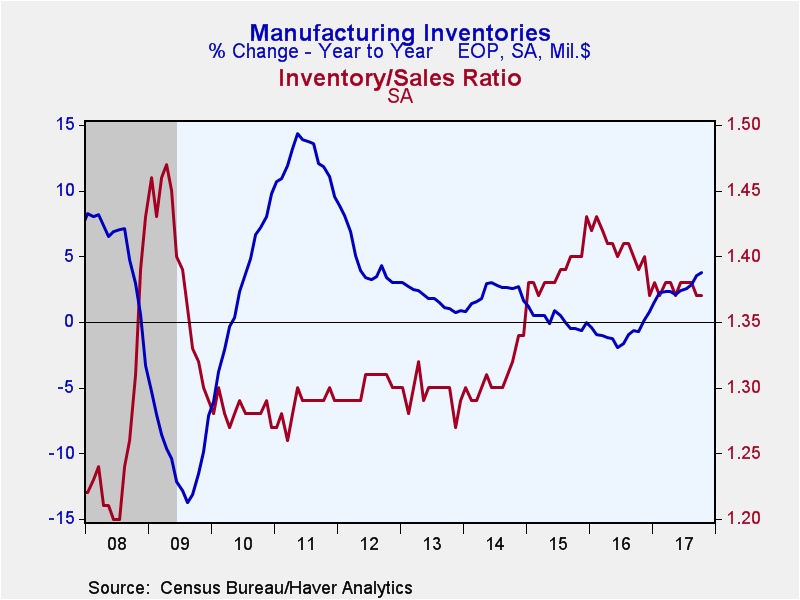 Global| Dec 14 2017
Global| Dec 14 2017U.S. Business Inventories Decrease Slightly as Sales Show Moderate Advance
Summary
Total business inventories decreased 0.1% in October (3.5% y/y) after being basically flat in September; the September total was revised downward ever so slightly from its initial report. Total sales at retailers, wholesalers and [...]
Total business inventories decreased 0.1% in October (3.5% y/y) after being basically flat in September; the September total was revised downward ever so slightly from its initial report. Total sales at retailers, wholesalers and manufacturers gained 0.6% (6.5% y/y), moderating after September's 1.6% surge, which was revised from 1.4% reported initially. The decline in inventories and the rise in sales put the inventory/sales ratio at 1.35, down from 1.36 in September and 1.39 in October 2016. This latest I/S ratio is the lowest since December 2014.
By distribution sector, inventories at retailers were flat in October (up 2.7% y/y), following their 0.9% decrease in September. Motor vehicle and parts dealers' stocks fell 0.7% (+3.9% y/y). Excluding that large motor vehicle segment - 35.6% of total retail inventories so far this year - other retailers' inventories rose 0.4% in October (2.1% y/y). The largest October increase was at building materials, garden equipment & supplies stores, 0.6% (3.8% y/y). Food & beverage stores had a 0.4% rise (2.9% y/y), general merchandise stores, 0.2% (-1.1% y/y) and clothing and accessories stores, 0.1% (-0.7% y/y). Inventories at furniture & appliance stores declined 0.6% in October (+1.7% y/y). At other distribution sectors, inventories at merchant wholesalers fell 0.5% (+3.9% y/y) in October after edging up 0.1% in September; those at manufacturers rose 0.2% (3.8% y/y) following September's 0.6% increase.
On the sales front, as described elsewhere on Haver.com today, retailers' sales in October gained 0.6% (+5.2% y/y); excluding the motor vehicle sector, they rose 0.4% (+5.0% y/y). Wholesale sales advanced 0.7% (+8.4% y/y) and manufacturers' shipments increased 0.6% (+5.8% y/y).
The lower inventory/sales ratio for total business In October was mirrored in the retail and wholesale sectors; that in manufacturing was flat. For retailers, the ratio edged down to 1.43 in October from 1.44 in September; it had been 1.47 in October 2016. Excluding motor vehicle dealers, the ratio was unchanged at 1.22 in the month and compared to 1.27 a year ago. For motor vehicle dealers specifically, the ratio dropped to 2.13 from 2.17 in September; it had the same 2.17 reading in October 2016. Furniture & appliance stores also saw a sizable drop, to 1.52 in October from 1.56 the month before and 1.57 the year before. The ratio in clothing stores was 2.37, down from 2.39 in September and 2.44 in the year-ago month. For wholesalers, the ratio was 1.25 in October, modestly lower than September's 1.26, with a more noticeable decrease from the year-ago 1.30. Manufacturers' inventory/sales ratio was 1.37, the same as September's 1.37 and modestly lower than 1.39 a year ago.
The manufacturing and trade data are in Haver's USECON database.
| Manufacturing & Trade | Oct | Sep | Aug | Oct Y/Y | 2016 | 2015 | 2014 |
|---|---|---|---|---|---|---|---|
| Business Inventories (% chg) | -0.1 | -0.0 | 0.6 | 3.5 | 2.3 | 1.8 | 3.4 |
| Retail | 0.0 | -0.9 | 0.6 | 2.7 | 3.8 | 4.7 | 3.0 |
| Retail excl. Motor Vehicles | 0.4 | -0.1 | 0.3 | 2.1 | 1.8 | 3.8 | 2.6 |
| Merchant Wholesalers | -0.5 | 0.1 | 0.8 | 3.9 | 2.5 | 1.2 | 5.8 |
| Manufacturing | 0.2 | 0.6 | 0.6 | 3.8 | 0.8 | -0.1 | 1.6 |
| Business Sales (% chg) | |||||||
| Total | 0.6 | 1.6 | 0.8 | 6.5 | -0.1 | -3.2 | 2.8 |
| Retail | 0.6 | 2.3 | -0.1 | 5.2 | 2.7 | 1.9 | 4.0 |
| Retail excl. Motor Vehicles | 0.4 | 1.6 | 0.5 | 5.0 | 2.3 | 0.4 | 3.3 |
| Merchant Wholesalers | 0.7 | 1.4 | 1.9 | 8.4 | -0.5 | -4.9 | 3.6 |
| Manufacturing | 0.6 | 1.1 | 0.6 | 5.8 | -2.0 | -5.8 | 1.3 |
| I/S Ratio | |||||||
| Total | 1.35 | 1.36 | 1.38 | 1.39 | 1.40 | 1.38 | 1.31 |
| Retail | 1.43 | 1.44 | 1.49 | 1.47 | 1.48 | 1.45 | 1.43 |
| Retail excl. Motor Vehicles | 1.22 | 1.22 | 1.24 | 1.27 | 1.27 | 1.26 | 1.23 |
| Merchant Wholesalers | 1.25 | 1.26 | 1.28 | 1.30 | 1.33 | 1.32 | 1.21 |
| Manufacturing | 1.37 | 1.37 | 1.38 | 1.39 | 1.41 | 1.39 | 1.31 |
Carol Stone, CBE
AuthorMore in Author Profile »Carol Stone, CBE came to Haver Analytics in 2003 following more than 35 years as a financial market economist at major Wall Street financial institutions, most especially Merrill Lynch and Nomura Securities. She had broad experience in analysis and forecasting of flow-of-funds accounts, the federal budget and Federal Reserve operations. At Nomura Securities, among other duties, she developed various indicator forecasting tools and edited a daily global publication produced in London and New York for readers in Tokyo. At Haver Analytics, Carol was a member of the Research Department, aiding database managers with research and documentation efforts, as well as posting commentary on select economic reports. In addition, she conducted Ways-of-the-World, a blog on economic issues for an Episcopal-Church-affiliated website, The Geranium Farm. During her career, Carol served as an officer of the Money Marketeers and the Downtown Economists Club. She had a PhD from NYU's Stern School of Business. She lived in Brooklyn, New York, and had a weekend home on Long Island.









